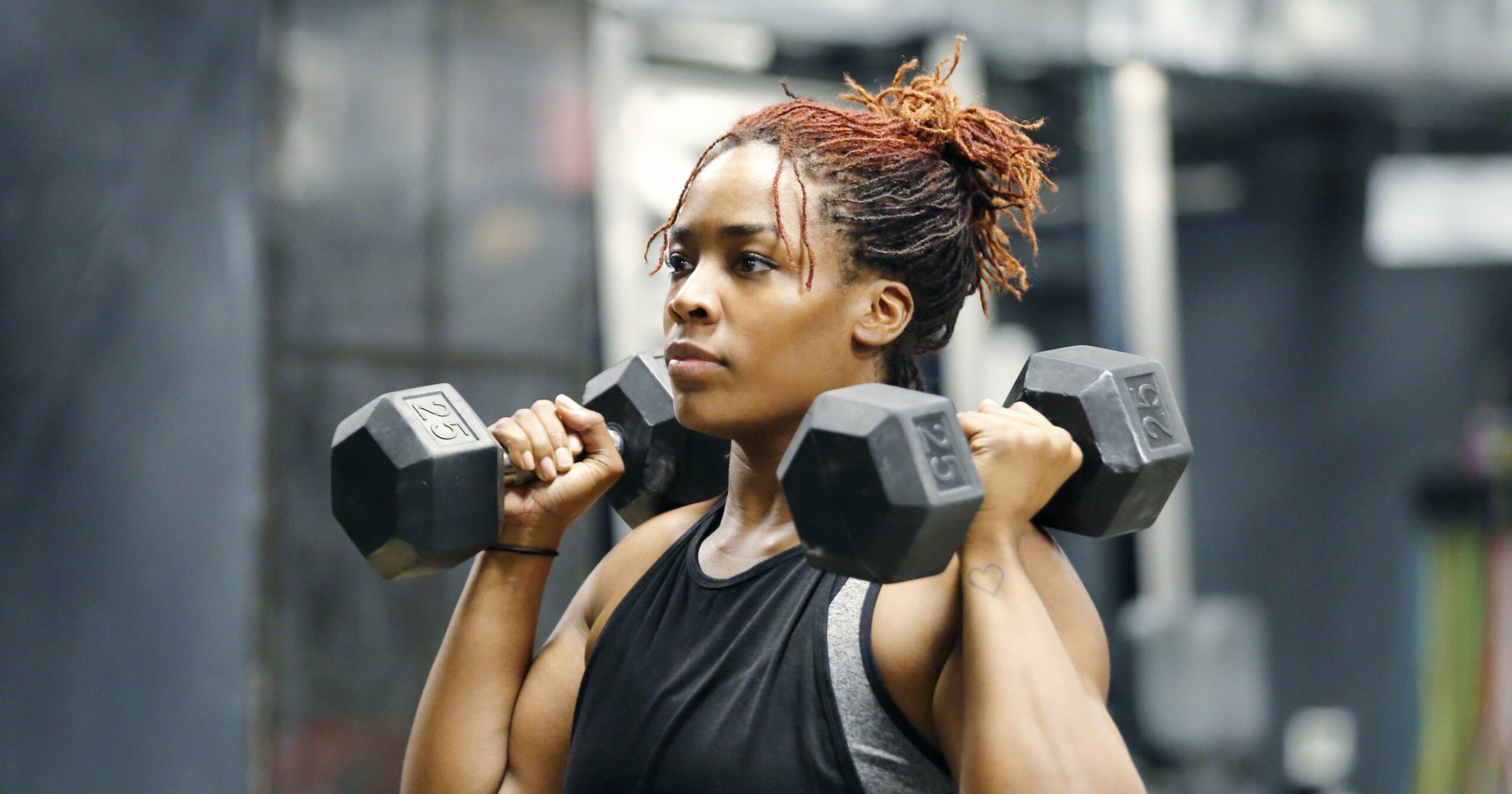There’s a lot of gym jargon out there – including the phrase “progressive overload.”
Maybe you’ve read about progressive overload in workout plans, come across info about it from a fitness professional on Instagram, or heard about it from a trainer – but you can’t quite define progressive overload. It sounds technical, but progressive overload is a relatively easy concept to understand and equally easy to incorporate into your training. Not to mention, it’s totally worth paying attention to for staying motivated and if you have specific fitness goals.
What is it? Put simply, progressive overload training involves gradually increasing the intensity or difficulty of your workouts over time, says Chad Barribeau, director of corporate stores for D1 Training. Progressive overload can be as simple as running one more mile or picking up a heavier dumbbell – and it can make a huge difference in your workout results. The main benefit of progressive overload is that it ensures you’re continually challenging your body, which can only lead to a stronger, more resilient you. Here’s everything you need to know about progressive overload, including how to incorporate it into your own workouts.
Experts Featured in This Article
Chad Barribeau is the director of corporate stores for D1 Training.
Jim White, RDN, is credentialed by the Academy of Nutrition and Dietetics as a registered dietitian, certified by the American College of Sports Medicine (ACSM) as an exercise physiologist, and the owner of Jim White Fitness & Nutrition Studios.
Eric Bowling, CPT, is a certified personal trainer through the National Academy of Sports Medicine and owner of Ask Eric Bowling.
What Is Progressive Overload?
Progressive overload is a training approach that focuses on gradually increasing the difficulty or intensity of your workouts. “It’s really done in four main ways: increasing resistance, increasing endurance or length of workouts, increasing tempo or speed, and increasing reps or sets,” Barribeau says. It’s often used in reference to strength training, but the principle of progressive overload can be applied to all workout types.
Progressive Overload: Why Does It Matter?
Progressive overload is all about challenging the body. That challenge is what results in changes like muscle gain or improved performance. “Whenever you’re applying a stimulus to the body and you’re trying to get some sort of physiological adaptation, you need to have enough variety or change or challenge to those muscles to get a desired result,” Barribeau says. Otherwise, you may find yourself stuck in a plateau.
Over time, your body adapts to handle the intensity of exercise you’re doing, says registered dietitan and exercise physiologist Jim White. Increasing the load on the body – by adding weight, time, speed, or reps – is what results in strength and muscle improvements. Otherwise, your body will become comfortable with what you’re repeatedly doing, and it won’t have to work as hard to get the job done. That could result in the halting of muscle growth and, in some cases, actual muscle loss, says Barribeau.
It’s important to note that many people use exercise to improve mental health and for mood-boosting benefits, and don’t care if they plateau – and that’s totally fine. If you don’t have a specific training goal or your main motivation for exercise is just to get moving and stay healthy, there’s no need to stress about incorporating progressive overload into your training. “You’ll still get that endorphin rush. You’ll still sweat and get your heart rate up – all of which do have a lot of health benefits for you,” Barribeau says.
However, if you want to run a faster 5K, lift heavier weights, or see changes in your body, progressive overload is your friend. “If you want to make progress, it’s going to require pushing your limits,” says certified personal trainer Eric Bowling. Not to mention, it can be really rewarding and empowering to push yourself harder than you’ve ever done before.
How to Incorporate Progressive Overload Into Your Training
If you’re a beginner, focus first on mastering form and getting comfortable with whatever exercise you’re doing before you consistently add weight, reps, time, or mileage, Barribeau says.
If you’ve been working out for a little while, there’s a good chance you already take steps to use progressive overload in your training without even realizing it. Humans are natural achievers; we tend to want to do more and be better, just because. If you’ve been holding planks for 30 seconds for a few weeks, it may be getting easier. As a result, you may have tried to hold a plank for 45 seconds. There you go – that’s tapping into progressive overload.
“I think intuitively people understand that they need to challenge themselves,” Barribeau says, “whether that be increasing from a mile run working up to two miles or adding in additional sets or reps or picking up a heavier weight when doing a certain exercise . . . but I don’t think they always know how to effectively and safely implement it.”
A good rule of thumb for a progressive workout plan is to increase your workout load (whether weight, reps, distance, or speed) by 10 percent or less each week, Barribeau says. This can ensure you’re challenging yourself while controlling your risk of injury or burnout. For example, if your heaviest squats this week were with 45 pounds of resistance, a safe bet would be to up your weight by four or five pounds next week.
If you want to train with progressive overload in mind, you can track your relevant workout data via the Notes app in your phone, an old-school notebook, a spreadsheet, or a workout-tracking app like TrainHeroic. You could also consult a trainer to get a personalized plan that works for you. But you certainly don’t need to do any of this: keeping progressive overload in mind can be as simple as upping the weight if a move feels too easy, taking on a few extra reps if you have more left in the tank, or striding a little bit faster when your favorite workout song plays during your morning run.
“The nuance to all this is you do need to listen to your body,” Barribeau says. It’s always OK to dial it back to make sure you’re training safely.
– Additional reporting by Christina Stiehl
Lauren Mazzo was the senior fitness editor at PS. She is a certified personal trainer and fitness nutrition specialist through the American Council on Exercise. Prior to joining PS, she worked for six years as a writer and editor for Shape Magazine covering health, fitness, nutrition, mental health, sex and relationships, beauty, and astrology.
Christina Stiehl is a former senior editor for PS Fitness. She is a writer, editor, and content strategist with more than 10 years of professional journalism experience, the last six of which have been focused in the health, fitness, and wellness space. Her work has appeared in SELF, VICE, SHAPE, Men’s Health, Thrillist, and more.




